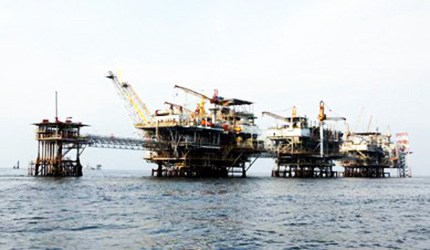
GLCC Technology
For decades, the Takula Field offshore Angola has been one of Chevron’s best producers in southern Africa. But through the innovative modeling and implementation of a gas liquid cylindrical cyclone (GLCC), those results got even better: Oil production rates increased by approximately 2,100 barrels of oil per day (bopd).
Wells across Takula send a flow of gas, oil, and water through three subsea pipelines to the platform more than a mile away. Despite high production rates, the flow became sluggish when gas and liquids moved in a chaotic mixing motion through the horizontal pipeline section on the sea bottom and up to the platform.
This flow dissipated energy and caused high backpressure on the wells, decreasing overall production potential.
“GLCC is a cost-effective way to maximize production where opportunities exist by reduction of system backpressure,” said Gabriel Ivaba, Takula area superintendent.
Simulation Models Uncover Alternative
During 2006-07, Chevron engineers began developing simulation models to explore adding new subsea pipelines to reduce the backpressure in our fields in southern Africa.
“Modeling the interaction between well performance and pipeline hydraulics was pivotal because it helped us identify that separating the gas and liquids would decrease backpressure in the Takula Field,” said Barend Uys, process engineer in the Facilities Engineering Optimization group. “Our models allowed us to do the math for many different scenarios and predict the production increase for each option.”
The group collaborated with Chevron Energy Technology Company (ETC) to evaluate alternatives to adding pipeline, such as installing a conventional separator or a GLCC.
A GLCC consists of a vertical pipe with a tangential inlet and outlets for gas and liquid. Flow is conditioned at the inlet to help spur the breakout of gas from the fluid. When fluid enters the vessel, it swirls into a cyclone, causing the liquids to move outward and down in the cylinder, while the gas travels inward and upward.
The smooth liquid-only or gas-only flow incurs less pressure drop and translates into a higher rate of production. Of the 20 well jackets in the Takula Field, the Takula Delta jacket’s conditions are ideal for the GLCC because of the high production, multiple pipelines, high backpressure, and optimum ratio of gas to liquids.
“It was really significant to identify the GLCC as the solution because we didn’t have to build any new pipelines or change anything with the existing pipelines, which is quite complicated and costly,” said Jimmie Riesenberg, an ETC engineering manager. “It’s much easier to build something on the surface than to lay another pipeline in the sea.”
A secondary benefit of the GLCC is that less pipeline resistance translates to lower pressure all the way down the wellbore, making it easier to inject gas at greater depths.
“The deeper we can inject, the more effective the gaslift system becomes at lifting oil out of the wellbore, ultimately leading to a greater capture of barrels,”Uys said.
The GLCC Advantages
The GLCC is also more compact, lightweight and less costly than conventional gravity-based separators. And because it was invented by Chevron in the early 1990s, the company had strong in-house design capabilities.
“It’s very suitable for a remote unmanned facility due to its small footprint, and it has significantly lower operating weight for deck extension installation,” said Pannawat Nilkitsaranont, project engineer with Takula facilities engineering.
The biggest challenge was getting the equipment to Angola and coordinating offshore construction logistics. Also, it was a challenge to install the deck extension for the GLCC unit because there wasn’t a platform crane or heavy lifting barge support at the site. Instead, two special lifting frames equipped with 10-ton winches were built on top of the well jacket to hoist and set the prefabricated deck extension into position.
The project was achieved with an incident-free safety record after approximately 52,000 construction hours between onshore and offshore activities. Use of the GLCC has resulted in a safer operation with less hydrocarbon inventory and a lighter lift.
Initial screening indicates that one or two additional GLCC opportunities may exist in Takula.
“We are reviewing other opportunities to apply this technology and increase oil production,” said Scot Buell, base business manager and petroleum engineering consultant for Cabinda Gulf Oil Company. “The experience gained should make the next GLCC faster and less expensive to implement.”